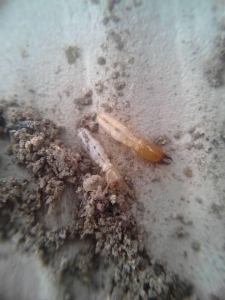Part of nature’s clean up crew for dead wood and debris — subterranean termites.
However, subterranean termites lack the ability to distinguish between a dead tree and the structure of your home. Termites feed on products that contain cellulose, including dead trees, lumber, and paper products.
What are Subterranean Termites?
As their name suggests, subterranean termites live below ground a majority of the time; however, they travel into the structure of homes by building shelter tubes known as “mud tubes” in order to access food sources. Colonies are believed to reach as many as 2 million termites. A colony in ideal conditions can devour roughly 1,920 cubic inches of wood in a single year. That is equivalent to two and a half 2in x 4in x 8ft boards. Termite colonies remain active 24 hours a day, 7 days a week. Devouring the insides of timbers termites leave wooden beams severely weakened, threatening the structural integrity of the home or building.
Subterranean Termites vs. “Regular” Termites
Colonies contain termites of different roles or castes. Termites, in general, have shorter legs than ants, their antennae are straight and they have a broad waist. The termite worker is 1/8 to 3/8’s of an inch in length and is responsible for foraging, caring for the brood, maintaining the nest, and food storage. They also digest and feed other members of the colony. Soldiers resemble workers with enlarged heads and powerful mandibles. They are responsible for the protection of the colony. When the colony is under attack by ants the soldiers will use their broadheads to plug the narrow mud tubes. Their mandibles are used as a powerful additional defense mechanism. Colonies also have a king and queen who continue mating throughout their lives. Reproductive termites are known as termite alate or swarmer. Swarmers are winged and approximately ½ to 1 inch in length. Termite swarmers are frequently mistaken for swarmers produced by ant colonies. Swarming typically occurs following periods of high moisture in the spring or fall, but can happen throughout the summer following heavy rains. Swarming termites will lose their wings once they have landed at a new location suitable for establishing a colony at which time they breed and begin a nest in the moist ground.
**Join us for continued information regarding signs of a termite infestation and treatment and prevention for the protection of your home in the coming days. **
